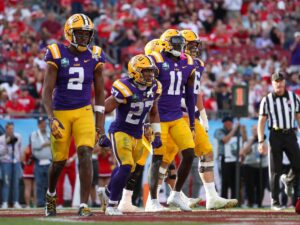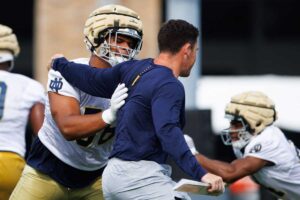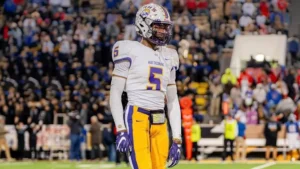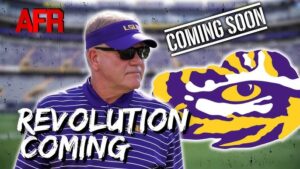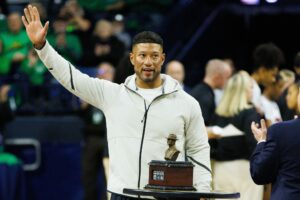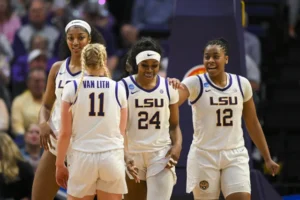
When you think of the most powerful forces in the world, you often think of things like energy, gravity, or determination. Yet in the world of sports, particularly basketball, one force stands above all others: influence. It’s not always about the loudest voice or the most aggressive actions. It’s about positive energy, leadership, and intelligence—the kind of intangible traits that lift a team, shape a culture, and drive success. Sania Feagin, a player who spent just two years with her program, demonstrated how just a short time can create a lasting impact, leaving a mark that will be felt for years to come.
In basketball, greatness is often measured by the number of points scored, the number of championships won, or the accolades accumulated. However, what truly defines greatness in the hearts of teammates, coaches, and fans is how a player elevates those around them. Sania Feagin did just that over her two-year career with her college program. It wasn’t the trophies or the statistics that made her impactful; it was her ability to bring people together, to inspire, and to lead with an unwavering commitment to the team’s success. In this journey, Sania exhibited not just raw athleticism, but an unmatched ability to understand the game, elevate her teammates, and influence the culture of her program.
The Power of Positive Energy: Creating a Culture of Confidence
One of the first things you notice about Sania Feagin is the energy she brings onto the court. It’s not the loud, brash kind of energy that can sometimes overwhelm a team, but rather a steady, positive, and infectious kind of energy that has the power to transform a group. She doesn’t need to speak loudly to be heard—her actions, her focus, and her determination speak for themselves. From the moment she arrived at her program, Sania exuded positivity, and it became clear that this energy was going to be a driving force for the entire team.
Positive energy is often overlooked in sports, but it is a key ingredient for success. When the atmosphere of a team is positive, it creates a belief that anything is possible. Teammates feel supported, encouraged, and motivated to push beyond their limits. Sania’s ability to bring out the best in those around her, even when times were tough, set the tone for her program.
Whether it was a tough loss or a tough practice, Sania was the first to bounce back with a smile on her face, ready to put in the work to improve. Her positive energy was contagious—one glance at her after a difficult moment, and suddenly the entire team was ready to move forward, to turn the page, and to get back to work. Her teammates often cited her energy as one of the factors that helped them stay resilient during tough stretches of the season. In basketball, where mental toughness is just as important as physical ability, Sania’s unwavering optimism gave her team the strength to push through adversity and come out stronger on the other side.
In just two years, Sania turned her program into a place where positivity wasn’t just encouraged, it was expected. She set the standard for how teammates should interact with one another, and how they should approach the game. The culture of positivity she cultivated has had a lasting impact, and it will undoubtedly continue to shape the program long after she’s moved on to the next phase of her career.
Leadership: More Than Just a Captain
Leadership is often assumed to be something that comes with a title—captain, team leader, or veteran. But Sania Feagin demonstrated that true leadership doesn’t always come with a formal designation. Leadership is about influence, and Sania’s influence on her program was immeasurable.
From the moment Sania stepped onto the court, her leadership was evident. She didn’t just lead through words, but through actions. Leadership in basketball is about setting an example, and Sania did just that in every practice, every game, and every interaction with her teammates. Whether she was diving for a loose ball, taking a crucial shot in a close game, or encouraging a teammate who was struggling, Sania led by showing what it meant to give everything for the team.
But Sania’s leadership wasn’t just about leading by example; it was also about being a vocal presence when needed. During timeouts, when the team was down and morale was low, Sania’s voice was the one that rang out above the noise. She was the one telling her teammates to keep their heads up, reminding them that they had the ability to win. She helped her teammates see their potential, even when they couldn’t see it themselves.
Her leadership extended beyond just her teammates. Coaches and staff also recognized her as a leader in the program. Her work ethic, her drive to improve, and her relentless pursuit of excellence made her a natural leader in the locker room, and on the court, her leadership was the glue that held the team together. Sania was someone who could motivate others to give their best and stay focused on the larger goal.
Perhaps one of the greatest testaments to her leadership was how seamlessly she was able to integrate into a team with players who were both younger and older than her. Regardless of age or experience, Sania was able to connect with every teammate, making everyone feel valued, heard, and supported. Her leadership was the embodiment of a team-first mentality—there was no ego, no hierarchy, only a shared commitment to success.
Basketball IQ: The Mind Behind the Game
While Sania’s athleticism and physical presence were undeniable, it was her basketball IQ that truly set her apart. Basketball is often called a game of “mental chess,” and the most successful players are those who can think the game several moves ahead. Sania had an exceptional understanding of basketball that allowed her to read situations on the court with remarkable clarity.
Whether it was on offense, where she could create opportunities for her teammates with her vision and passing ability, or on defense, where she anticipated the opponent’s next move, Sania’s ability to understand the flow of the game was exceptional. She didn’t just play the game; she felt the game.
Her basketball IQ allowed her to make adjustments on the fly, to see passing lanes before they opened, and to predict the opponent’s strategy based on their movements. This high-level understanding of the game made her an invaluable asset to her team. But what made Sania’s basketball IQ truly remarkable was her ability to communicate it to her teammates. She wasn’t just a player who understood the game—she was a teacher, constantly helping her teammates read the game better and improve their understanding of the court.
Her sharp basketball mind also made her a tactical asset for her coaches. When the team was struggling with a particular matchup or strategy, Sania was often the first to suggest a solution, offering insights that showed a deep understanding of the game’s intricacies. Her ability to think and react quickly under pressure was something that made her stand out not just as a player, but as a strategist.
A Two-Year Legacy: Impact Beyond the Stats
While statistics are often the first thing people look at when evaluating an athlete’s impact, the true measure of a player’s legacy isn’t always reflected in points, rebounds, or assists. Sometimes, it’s about the intangible qualities that a player brings to the table—qualities like leadership, energy, and intelligence.
Sania Feagin’s two years with her program were filled with moments that transcended the box score. From her leadership on the court to her positivity off it, she had an impact that will be felt long after she moves on to the next chapter of her career. Her ability to elevate her teammates, to create a culture of positivity and resilience, and to lead with both her heart and mind has shaped the program in ways that cannot be quantified by statistics alone.
In the end, Sania’s greatest contribution was not just her play on the court, but the lasting impact she made on those around her. Her two years may have been short, but the influence she had on her program is immeasurable. Sania Feagin has left an indelible mark on her team, and that is a legacy that will never be forgotten.
